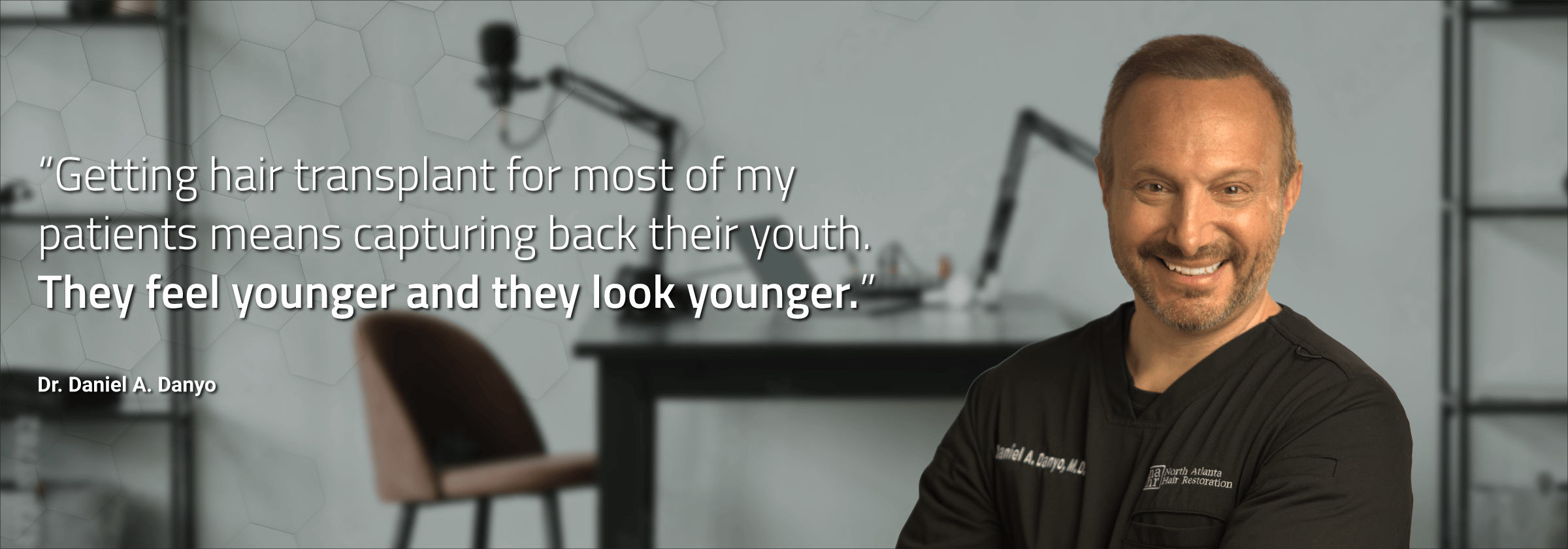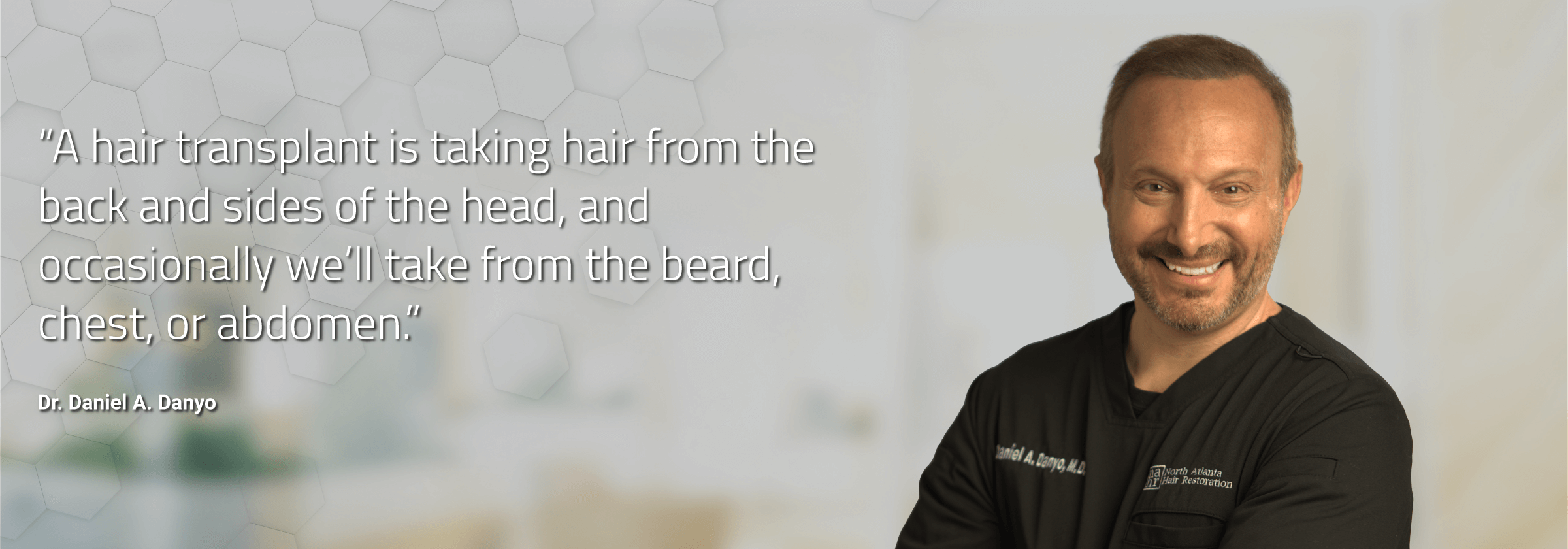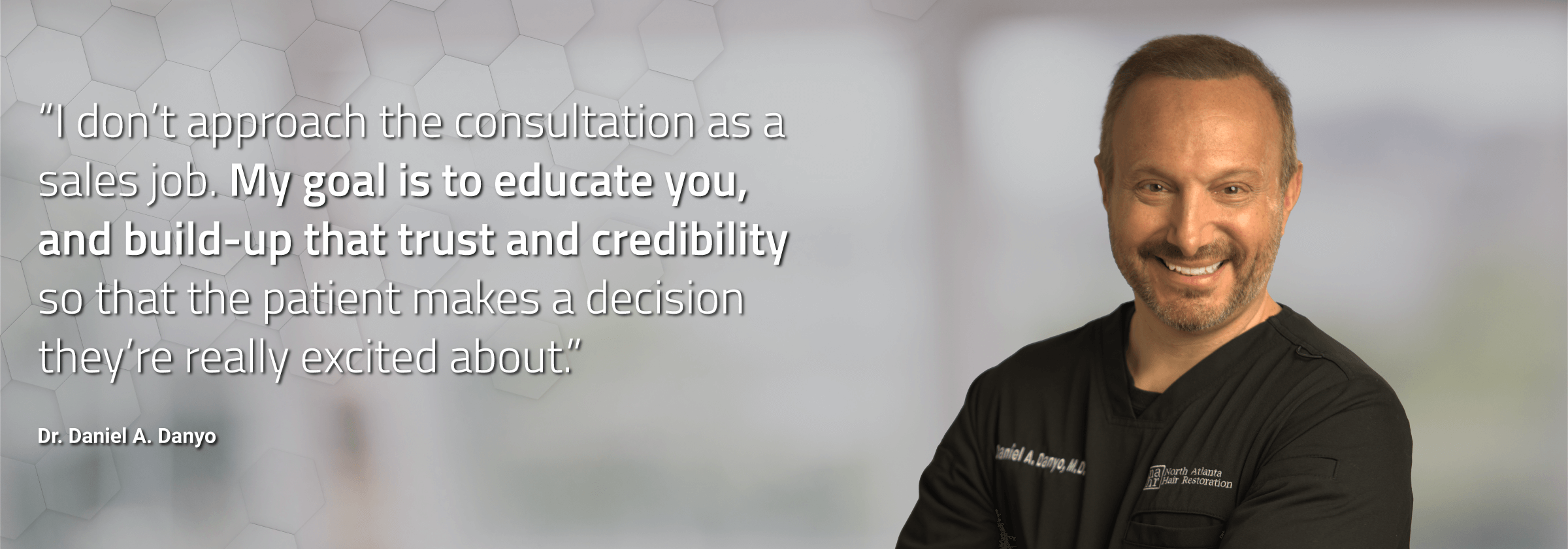The following is a transcript of Episode 11 of the Hair Restoration With Dr. Daniel A. Danyo podcast.
All episodes of the podcast can be found at Apple Podcasts, Google Podcast, and Spotify.
Dr. Danyo: Getting hair transplant for most of my patients means capturing back their youth, they feel younger, that they look younger. It translates into having better relationships with their spouse, feeling better emotionally. And that’s huge. And hair loss is such a devastating thing and when you can permanently restore it, it’s a wonderful thing.
Clark: That was the voice of Daniel A. Danyo, MD, founder and physician at North Atlanta Hair Restoration. They’re a boutique medical practice solely dedicated to the diagnosis and treatment of male and female hair loss in Atlanta. And you’re listening to “Hair Restoration” with Dr. Daniel A. Danyo. I’m your host Clark, and all season long. We’re speaking with Dr. Danyo about how he and his team at North Atlanta Hair Restoration, are helping his patients transform their everyday lives for the better. In this episode, Dr. Danyo and I discussed the incredible science behind hair transplantation, starting with the genetic expressions of every hair follicle on the human body, followed by his detailed techniques of hair restoration. Dr. Danyo also shares why his initial consultation which he does himself with every new patient is so important to the success of the process. There’s so much to talk about. So, let’s dive right in. Dr. Danyo, welcome back. How are you doing?
Dr. Danyo: I’m doing great. How are you, Clark?
Clark: I’m doing well. How have you been since we talked last?
Dr. Danyo: Doing great. My 19-year-old daughter, I guess I inspired her. She signed up for a half Ironman in May…
Clark: She signed herself up or she signed you up?
Dr. Danyo: No, she signed herself up. And…
Clark: Are you going to join?
Dr. Danyo: I’m going to join her.
Clark: What?
Dr. Danyo: Yeah.
Clark: Have you done one before?
Dr. Danyo: I’ve done half and I’ve done two fulls.
Clark: I did not know that. Whoa. And so this will be her first half Ironman. Is that right?
Dr. Danyo: Yes.
Clark: Well, I know, she has started college recently. And that’s an exciting time that she is being able to stay focused to take something on like that. And definitely excited to hear how that goes.
Dr. Danyo: Yes.
Clark: Super cool. Well, thanks for that update.
Dr. Danyo: Yeah.
Clark: So, today’s topic, we’re talking about hair transplants.
Dr. Danyo: Yes.

Clark: And there’s a lot of questions around what is that? And also, how does that actually happen? I know in the past years and years and years ago, this whole industry really took a beating, I think from just the old technology, the old techniques, and it was new and that did not… It is night and day difference between then and now. So, as we sort of start to just tee this up, what is a hair transplant? And how is it and why is it different than the old ways of doing that?
Dr. Danyo: Sure. A hair transplant is taking hair from the back and sides of the head, as occasionally we’ll take from the beard, chest, or abdomen. People have a need for a lot of grafts and need a lot of coverage. But the sides and back of the head are actually genetically or the hair follicles are genetically different than on the top of the head for people that have hair loss. The main thing for men is that if there’s male pattern hair loss, there’s something called dihydrotestosterone or DHT. There’s a receptor associated with that follicle in the activation of that receptor essentially, slowly kills the hair to where the hair starts to shrink, and you start losing volume and then it goes into kind of a reduced growth phase and then starts going dormant and then eventually, you know, dies. And that’s kind of the process. So, with hair transplant, you’re taking a hair that does not have the DHT receptor. And when you move it, it keeps its same genetic code in genetic expression. So, when you move it even though you move it into an area that has hair loss, that hair that we move doesn’t have a DHT receptor, so it’s not programmed to die. So, it’s a permanent move.
Clark: Whoa. I had no idea that was going on with each individual hair. It’s so interesting to hear about the science on how this works. So, are there any analogies you can think of on just how to imagine and visualize what’s happening?
Dr. Danyo: I think if you look at your lawn, I think of my house that I live in when we first bought it, our lawn was looking really bad. And there were areas that had no grass and the rest of the lawn had weeds, and it just was not looking well. So, the areas where there was no grass, we had to put sod down. So, the analogy for the lawn is that that’s like hair transplant, if there’s no grass to kind of fertilize, then you’re going to have to bring grass in. The rest of the lawn would be more like medical management, where it’s thinning out, and we fertilize it and aerated and it came back. So, with hair transplant, we’re going into areas where the hairs have essentially died, or the follicles have. And we’re bringing essentially new grass into our new grafts into those areas to replenish that.
Clark: And earlier you were mentioning you can not only pull hair from the side in the back of someone’s head, but you were mentioning other places too, like chest or beard. How does that compare, like, I’m sure that’s a different DNA, right? Like, how does that flow?
Dr. Danyo: Yes. So, I mean, every region of the body, from eyebrows to eyelashes to beard, chest, arm, leg, they all have different genetic expressions. So you look at the arm, you could shave your arm, and then two months later, the hair is growing back at the same length, and you think how did this just happen? Well, the fact is, the hair and the arms are constantly shedding, and usually, the growth cycle is about 120 days. So, once it gets to a certain length and time, it literally sheds. So, that’s how the hair length is maintained. Now in the head, the growth cycle for men is about four years, and for women, it can be up to six years for individual hairs before their shed. So, it’s natural that each follicle goes through a growth phase, and then it goes into a resting phase where the follicle is shed. So, when you look at different areas of the body, the beard actually has a very similar growth cycle to the head.
Now, the chest is a little different, as well as abdominal hair because it’s a 70:30, maybe even a 60:40 ratio where it’s in a growth cycle for 60% to 70% of the time, and then it goes into a rest phase. But, you know, when you move it to the head, it does take on some of the characteristics of the head growth cycle. And obviously, beard and chest hair can have a different coarseness, and it all comes into doing an in-depth consultation coming up with a game plan as far as where you’re going to put those hairs. I usually mix them in with head hair. So, it’s kind of evenly spread or just fill in with that. But the nice thing about the beard and the chest is because of the coarseness, you get a lot more volume and potentially more coverage per follicle graft.
Clark: Interesting. So, I love the analogy and really helps me understand what’s happening. I am curious to talk a little about some examples. Some folks, you’ve worked with just general ideals of just, you know, who they were what kind of needs they had. Are there any examples that you could share?
Dr. Danyo: Well, I think in general, what I hear quite often, and what I tell patients is that hair transplant will make a younger version of yourself. And it carries over into so much other things like improved mood, improved sense of self, improved confidence…
Clark: That matters.
Dr. Danyo: … and a lot of… Oh yeah, especially for women, you know, it can be more devastated at times than for the men. And, you know, when they get permanent hair back, you know, it’s an amazing thing. You know, in our follow-ups, even at six months, you know, well, during COVID I’m gonna say it’s elbow, you know, bumps in fist bumps, but I typically say it’s high fives and hugs, I mean, people come in, there’s a visible improvement, especially at 12 months of the follow-up. And that’s what’s so great about hair transplant is that it’s very consistent. I’ve had very few patients that haven’t been satisfied. And the people that didn’t have good growth had different factors associated with it, where we had to go back and do some more. And oftentimes people with thinner hair may need another procedure because they don’t have the volume, you know, thinner hair just doesn’t cover as much as say, somebody has got really thick stranded hair. But that’s what’s so wonderful about doing what I do is the follow-ups are just really awesome. And almost across the board, you know, very satisfied.

Clark: So, I hear you use the word grafts, and that’s part of the procedure and how many grafts some people need, sometimes it’s more, sometimes it’s less. Could you talk a little about that, and how this technique works, and what’s actually happening when someone is getting a hair transplant?
Dr. Danyo: Sure. Well, it all starts with the initial consultation, and in my office, I do all the consultations. A lot of offices there’s a salesperson or non-physician during the consultation, but I think it takes a doctor first rule out any medical conditions that need to be evaluated and treated first and make sure that you have the right diagnosis of male pattern or female pattern hair loss versus some other type of alopecia. Because, you know, some scarring alopecia, especially if they’re still active, you do grafting and it’s not going to take. So, you know, that’s the first part of the consultation is just get the diagnosis. The next is to determine the areas of involvements and then how many grafts are going to be required to fill in those areas.
So, generally, I look at kind of the front part as a separate procedure from the back pupping the crown for the guys, if they have both involved, because I think it’s safer to split them up by at least six months, if not longer, so you don’t damage the donor site by doing too much at one time. So, the first inch of the hairline is generally about 1,500 grafts. And so somebody who’s got just like some recession in the temporal areas, still has some hair in the front, and not much hair loss behind. I mean, oftentimes, we’re talking about 1,500 grafts or even 1,000 grafts to make that happen. And then if there’s more advanced hair loss, say, behind the frontal hairline into the middle scalp, it could be up to 2,000 to 2,500 grafts, sometimes even more. And the crowns are generally, I use the size of a DVD, is generally 2,000 grafts.
Clark: Okay. So, you’re individually going through, and you’re doing one graft at a time?
Dr. Danyo: Yes.
Clark: And typically that’s one hair or just a couple hairs at a time they’re in that, that follicle.
Dr. Danyo: Yes. Or in the graft.
Clark: In the graft?
Dr. Danyo: Yes.
Clark: So, how long does that take you to go through a couple thousand back to back, you know, making a graft and moving it to the desired area?
Dr. Danyo: 2,000 grafts generally takes between seven and eight hours to do extraction, and then placement.
Clark: Gotcha. And that’s you’re in and out, but that’s a full day for your patient to be back to back, right? That’s a full visit?
Dr. Danyo: Yes. It’s a full visit. Now, a lot of times we’ll do some oral sedation, where people, you know, sleep much of the morning and intermittently sleep in the afternoon. And by the time they leave, the sedation is worn off. And then when you throw in the nerve blocks, and anesthetic blocks that we do, the actual procedure is not painful. You don’t feel the grafting or you don’t feel the placing of the grafts. And if you do, you know, we just ask the patient so let us know, we just, you know, put in a little bit more anesthesia, you know, it’s not an issue. So, pain during the procedure in the actual process goes by really quick. And I’ve had a lot of patients tell me, this is the most relaxing day that I had in a long time.
Clark: That’s what you want to hear.
Dr. Danyo: Yes.
Clark: There’s got to be a lot of emotion that going into this when you make that decision. There’s a lot of thought that’s gone into this?
Dr. Danyo: Yes.
Clark: And I’m sure there’s a lot of emotions that they’re feeling, so put them at ease like that and making it as easy as possible.
Dr. Danyo: And I try and gauge the emotion. I did a consult yesterday, was somebody that he’s a younger guy, I think he’s 29, the hairline was starting to dissolve, but he hadn’t done any medical management and he wasn’t there emotionally. And I asked him, “Is this affecting you emotionally?” And he said, “No, but it’s a bummer.” So, we opted to not do hair transplant at this time, try some medical management with some oral medications like finasteride, some minoxidil Rogaine, and then also do some platelet-rich plasma injection therapy, see how that goes over the next 12 months, and if there’s not much of improvement, then we’d pull the plug to possibly go forward with hair transplant. Then on the other side, I had an 18-year-old patient that he really didn’t have any frontal hairline loss, but the way his hair kind of came out, he had really minimal growth on the sides of his head, like, in front of his ear, it almost went backwards.
Clark: Interesting.
Dr. Danyo: And it looked like he had this, like, really deep recession, and given his head-shaped, it wasn’t very appealing. And it created so much emotional distress, that he was almost suicidal, his mom said.
Clark: Man.
Dr. Danyo: Now, he had seen five other physicians who said, “No, you’re too young, we can’t do this.” But when I looked at him, the recession is not going to go back on the side anymore. And it was really a deformity that he had that needed to be corrected. So, I ended up doing 1,500 grafts, 750 on each side, and he’s extremely happy. And so you have to, in the consultation, figure out what’s appropriate, what’s not. And just because somebody is at a certain age, you know, even the gold standard is to wait till you are age 30. But for him to wait 12 more years through the most productive stage of his life, and then just fix it when he’s 30, in my mind is unacceptable. And in his mind, he was at a very fragile state and something had to be done. And we did it. And he’s going to have a permanent, you know, fix of that deformity. And he’s extremely happy.
Clark: I love hearing that story. And I know we’ve talked about this before on the show, but it’s always great when you get to see the full circle when they come back and they’re able to celebrate with you. And you get to see that new spirit, that renewed spirit.
Dr. Danyo: Yes. Exactly.
Clark: That’s really special.
Dr. Danyo: Yes.
Clark: So, you’re talking about consults and the consultation process, and I think this might be a good transition. Talk a lot more about that, and how important that is to you. Because this is a truly a boutique service, I mean, they’re dealing with you the whole time, you don’t have other folks coming in after you check them in. And you come back at the end of the day and say “How did it go?” You’re actually… you’re doing all of these grafts, you’re working with them from the very beginning. So, tell me about that consultation process and how you’re different?
Dr. Danyo: Sure. Well, I think, you know, the first thing is rule out any medical issues, and really put all the factors in place to determine, are you a candidate, are you not looking at all the emotional things that we talked about earlier? And then, you know, kind of, in their mind, it’s my job to crystallize the outcome. And that’s done through education, you know, talking with the patient. So, a lot of these consults, I spend 45 minutes to an hour talking about the whole process from start to finish, what we’re going to do, but that outcome is also crystallized when you have before and after pictures and videos that you can show them, my reviews, we’ve got some really good reviews, they are all personalized. We’ve got stories on our website and on Facebook of people that have gone through, and that crystallization is important because it ultimately establishes trust and credibility, which is so important going into this. And, you know, that also eliminates uncertainty, you know, which is key.
Clark: What’s really interesting is that someone, if they’re visiting with you, and they’re interested in this, they probably are pretty sure that something needs to change. Now, it’s just a matter of, can you help me feel better and make this a smooth experience? Sometimes it’s their first time trying to do something and in other instances, I know you’ve worked with people who’ve seen other people and they did not get the results they were hoping for.
Dr. Danyo: Yes. And in the back of their mind, they’re thinking hair plugs, hair plugs is this going to look unnatural.
Clark: That’s scary. And that’s not what this is.
Dr. Danyo: Yes. And…
Clark: That is all ancient technology, right?
Dr. Danyo: Yeah. And I don’t approach the consultation as a sales job, you know, my goal is to educate you, and kind of build-up that trust and credibility so that the patient makes a decision and they’re really excited and happy about moving forward. The next thing that I talk about is, you know, I’ve eliminated a lot of the risk for doing this. For one, the outcomes, I think we’ve got great outcomes and we’ve got proof of that. But the next is that since I’m doing all the medication application with the anesthesia, the nerve blocks, I do all the extractions and I place all the hairs. And I’ve said this before, I have a high level of OCD, when I do this, we’re getting great grafts. But doing it in a very safe manner to where people don’t have swelling, they don’t have pain, and ultimately don’t have complications, you know, that can arise from doing any type of procedure, we really minimize that risk with my full involvement.

Clark: Your full involvement from start to finish, and you’ve surrounded yourself with a great team. So, it really is a comfortable experience from the very beginning. And being located in Atlanta, I understand a lot of people will come from all-around and they’ll make a weekend stay out of it. Even though with your techniques with hair transplants, you could actually go back to work pretty much the next day but people make a weekend trip out of it.
Dr. Danyo: Yes, oftentimes bringing their spouse and their kids. You know, we’re situated in Alpharetta, which is North of Atlanta, and we’ve got a new Downtown, we have the Avalon, which is just a great outdoor, you know, shopping, living restaurant space. And there’s plenty of things in and around Atlanta to do. But, you know, the accommodations that we recommend for people, some are higher-end and some are, you know, kind of medium. But when they bring their spouse and the spouses are out shopping or doing things during the day or with their family, it just makes the whole experience so much better for the patient and for the family. Because really, the spouse is affected. And, you know, when we do a No-Shave procedure, and the spouse comes in kind of real timid, and they walk in, they’re like, “Oh my gosh, this looks great. This is nothing like I’ve thought.” And people don’t leave with bandages, and we don’t [inaudible00:22:55.926] people and so, you know, they feel very empowered when they leave, you know, just all clean, we blowdry, everybody, wash the hair. And we try and get people looking, especially with a No-Shave, as if they had just walked in. And that’s a huge thing. And that translates into people spending time in Alpharetta and actually doing things the next day, thinking they would be laid up, you know, for a week or something like that, it’s just not the case.
Clark: Fantastic. I love hearing those examples and hearing more about the process and the consult and all of that. So, as always, Dr. Danyo, thank you for taking some time out. I know you got a busy day, but thanks for sharing all about this, and I’m looking forward to our next conversation.
Dr. Danyo: Likewise, have a great night.
Clark: Thanks for listening to “Hair Restoration” with Dr. Daniel A. Danyo. Book your consultation today with Dr. Danyo by simply calling 678-845-7521 or visit them online @nahairrestoration.com and be sure to subscribe, rate, and review the podcast wherever you listen to your favorite podcasts.

